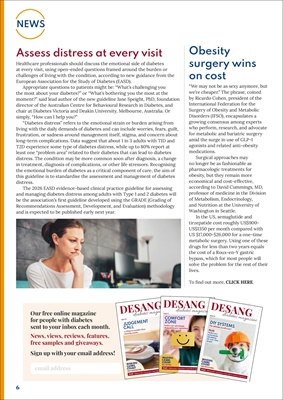
6
NEWS
Obesity
surgery wins
on cost
"We may not be as sexy anymore, but
we're cheaper." The phrase, coined
by Ricardo Cohen, president of the
International Federation for the
Surgery of Obesity and Metabolic
Disorders (IFSO), encapsulates a
growing consensus among experts
who perform, research, and advocate
for metabolic and bariatric surgery
amid the surge in use of GLP-1
agonists and related anti-obesity
medications.
Surgical approaches may
no longer be as fashionable as
pharmacologic treatments for
obesity, but they remain more
economical and cost-effective,
according to David Cummings, MD,
professor of medicine in the Division
of Metabolism, Endocrinology,
and Nutrition at the University of
Washington in Seattle.
In the US, semaglutide and
tirzepatide cost roughly US$900-
US$1350 per month compared with
US $17,000-$26,000 for a one-time
metabolic surgery. Using one of these
drugs for less than two years equals
the cost of a Roux-en-Y gastric
bypass, which for most people will
solve the problem for the rest of their
lives.
To find out more, CLICK HERE.
Assess distress at every visit
Healthcare professionals should discuss the emotional side of diabetes
at every visit, using open-ended questions framed around the burden or
challenges of living with the condition, according to new guidance from the
European Association for the Study of Diabetes (EASD).
Appropriate questions to patients might be: "What's challenging you
the most about your diabetes?" or "What's bothering you the most at the
moment?" said lead author of the new guideline Jane Speight, PhD, foundation
director of the Australian Centre for Behavioural Research in Diabetes, and
chair at Diabetes Victoria and Deakin University, Melbourne, Australia. Or
simply, "How can I help you?"
"Diabetes distress" refers to the emotional strain or burden arising from
living with the daily demands of diabetes and can include worries, fears, guilt,
frustration, or sadness around management itself, stigma, and concern about
long-term complications. Data suggest that about 1 in 3 adults with T1D and
T2D experience some type of diabetes distress, while up to 80% report at
least one "problem area" related to their diabetes that can lead to diabetes
distress. The condition may be more common soon after diagnosis, a change
in treatment, diagnosis of complications, or other life stressors. Recognising
the emotional burden of diabetes as a critical component of care, the aim of
this guideline is to standardise the assessment and management of diabetes
distress.
The 2026 EASD evidence-based clinical practice guideline for assessing
and managing diabetes distress among adults with Type 1 and 2 diabetes will
be the association's first guideline developed using the GRADE (Grading of
Recommendations Assessment, Development, and Evaluation) methodology
and is expected to be published early next year.
Our free online magazine
for people with diabetes
sent to your inbox each month.
News, views, reviews, features,
free samples and giveaways.
Sign up with your email address!
ISSUE 115
MAKING
CARBS
COUNT
MILK ALTERNATIVES
PLUS Diabetes kit • Giveaways • News (for T1 and T2) • Food News
JUDGEMENT
CALL
10 things to consider when
choosing a meter
PLUS
Who's Zooming who?
An update on digital
health delivery
ISSUE 111
MAKING
CARBS
COUNT
BELL PEPPERS
PLUS Diabetes kit • Giveaways • News (for T1 and T2) • Food News
COMFORT
ZONE
Roche's new micropump:
designed for user satisfaction
PLUS
Dexcom's next
generation G7 sensor ISSUE 119
MAKING
CARBS
COUNT
LUSCIOUS LYCHEES
PLUS Diabetes kit • Giveaways • News (for T1 and T2) • Food News
DIY SYSTEMS
The ultimate in self-care?
PLUS
Roche's new
meter launch:
introducing
the Accu-Chek
Instant
email address